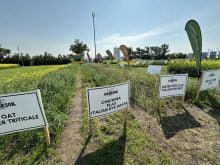It appears that the idea of farmers improving the soil is starting to take hold. The Western Canadian Soil Health Conference was held in Edmonton, Alberta, the first part of December 2015. Nora Paulovich and Tom Fromme, co-chairs on the organizing committee, did a wonderful job pulling speakers together and organizing it. It started at a registration limit of 250. It sold out in no time, so they bumped it to 450, which took less than a week to sell out.
Crop diversity, rotational diversity and, if possible, getting animals on the land, are the ways to start building soil health. Old time agronomy! It makes sense when some are talking about maintaining our soils, but why maintain a degraded resource? Our goal should be to improve our soil. When we build quality organic matter in the soil, microbes and earthworms will return to the soil. With the return of soil microbiology, natural soil fertility returns.
Read Also

Cancer agency reclassifies another herbicide ‘probably carcinogenic’
The WHO’s cancer research agency has now put atrazine, a herbicide well known to corn growers, in the same potential-hazard category where the agency put glyphosate.
Soil fertility
Most of the natural fertility from the soil can be traced back to mycorrhizae, a naturally occurring fungus in the soil that works with grasses, legumes, forbs and some broadleaf plants. The mycorrhizae work with the plants. In exchange for carbohydrates, the mycorrhizae provide the plant with water and nutrients the plant normally has lower access to. To survive, the mycorrhizae require a food source, high quality organic matter, living plants and a place to live. High disturbance “recreational” tillage breaks down the organic matter and kills plants.
Another source of nutrient cyclers are the earthworms. At the Edmonton conference, I had an enlightening discussion with Dr. Jill Clapperton, scientist and co-founder of Rhizoterra, a U.S.-based company that helps farmers create healthy soils. She educated me on earthworms.
Earthworms burrow in the soil, creating tunnels that they travel in. They eat organic matter, bacteria, protozoa and fungi. They then defecate in their tunnels. Microbes grow in their feces; earthworms return and eat their own feces.
Fungi in the soil are the preferred food source for most of the soil life. Fungi contain a more balanced nutrient concentration in their cells, creating a better food source. Earthworms are an indicator of soil health.
Fungi just do not digest organic matter, fungi are attracted to high quality organic matter. This is one of the areas where cover cropping gives producers the ability to ensure that our “soil livestock” have the correct nutrition. Producing high-quality organic matter to return to the soil to feed our microbes. Building organic matter drives soil health and natural soil fertility.
Rotations and soil health
One of the cornerstones of a “good” crop rotation is including grasses and cereals, broadleaf and legume crops, both warm and cool season. To get a “great” crop rotation, one would include spring- and fall-seeded crops, perennials, and annuals. The ultimate goal in utilizing cover crops is to have plants growing in the soil throughout the growing season.
A good crop rotation will increase “soil livestock.” But how does increasing fungi, in particular mycorrhizae, make me money? There is research in southern Manitoba showing that adding phosphate fertilizer to soybeans leads to significant yield increases. Yet on our farm, we are yet to show any yield increase from phosphate. Scientific papers published around the world show that fields with high levels of mycorrhizal infection show low yield response to phosphate fertilizers, where fields with low mycorrhizal infection show a higher yield response. Other crops like flax, corn, cereals, and pulses, respond similarly. High levels of mycorrhizae in the soil may lower your phosphate bill.
Mycorrhizae also help move water around in the soil under drought stress. If the soil surface is covered, and the mycorrhizae population is healthy, crops will handle drought better. The key is to maintain ground cover, keep roots alive throughout the growing season, build organic matter, build soil fertility and maintain nutrient balance.
Cover cropping goals
Cover cropping can be full season, part season or short season growth, depending on goals. A cover crop can be simple or a complex blend of different species. With more diversity comes more stability. For producers looking at cover crops for the first time, simplicity usually takes some of the stress and intimidation out of getting started. As a producer gains experience cover cropping, new goals can be added.
Livestock producers usually see quicker direct benefits, such as animal feed. Either as grazing or hayed forage, there is usually a feed target for a cover crop to fill. This has been done for many years, back before it was “cool.” The difference now is that we are also able to target other goals: recycling nutrients, alleviating compaction, or reducing salinity buildup by choosing species with appropriate growth periods, root growth, top growth and feed characteristics.
How does cover cropping benefit grain producers? Healthy soil biology will assist in plant growth and reduce plant stress. When plants are growing in the soil throughout the growing season, soil microbes have something to grow with.
A cover crop will address production issues. Seeding fast-growing species after crop harvest, or something that will overwinter, will continue to improve soil conditions.
Overwintering cover crops is the next step in management, which is not a big deal. An abundance of nutrients can be recycled or nitrogen fixed by the right species. The main complaints are lack of time and the fear of drying out the soil. Increased soil biology and increased organic matter will ease both fears. The biggest thing is to start changing management.
The whole idea of soil husbandry disappeared from Western Canada in the 1930s. My grandfather was a member of the Saskatchewan Field Husbandry Association. With the advance of science, a lot of that work was left behind. Now, old time agronomy is making its way back.
Taking care of the soil, feeding microbes, is easier and less risky than the continued reliance of over applying chemical inputs. No, this is not a plug for organic or non-GMO production. We conventional producers can learn some easy-to-incorporate management choices from top end organic producers. I like the idea of having a toolbox full of tools I can use, not being stuck using half of the potential tools. It will take some trials to see what you’re your management system. You just need to think of the “livestock” living in your soil.














